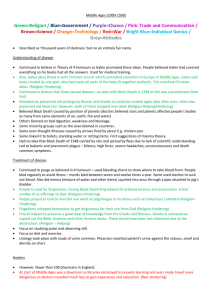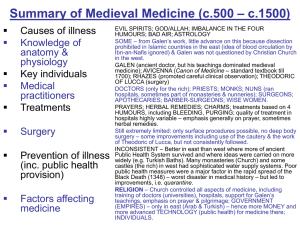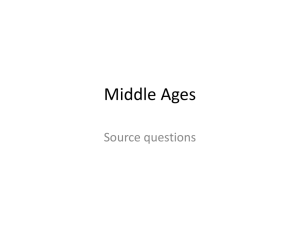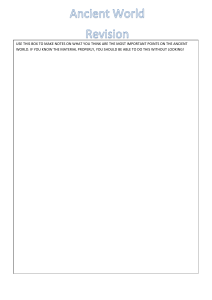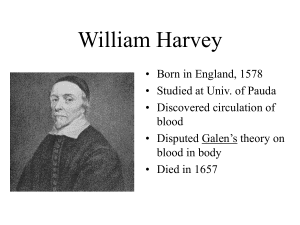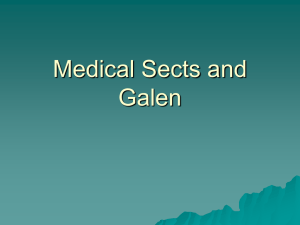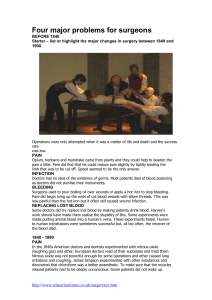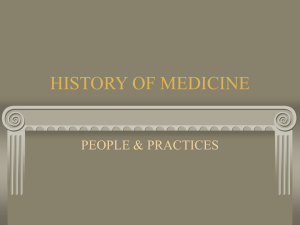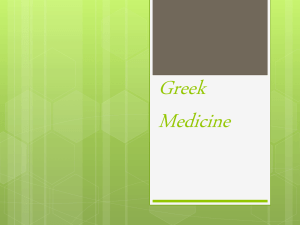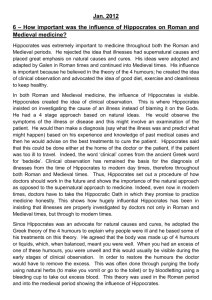Medicine Revision Booklet
advertisement
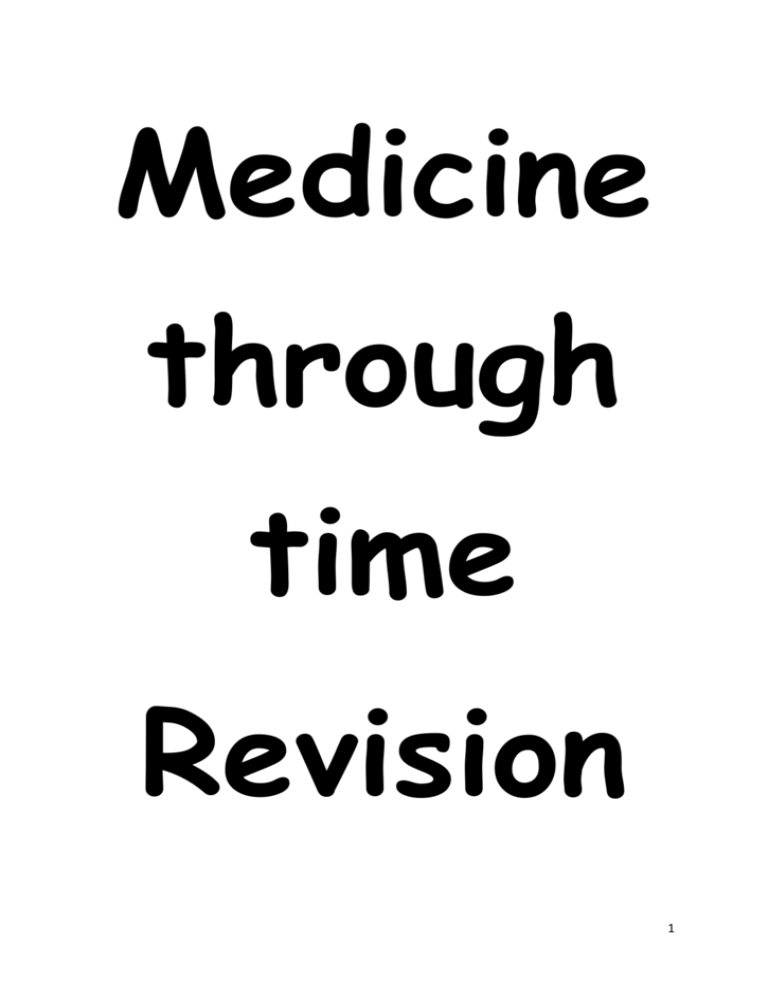
Medicine through time Revision 1 Prehistoric Medicine Although we can never be totally sure what life was like in prehistory, combining different sorts of evidence allows us to make a good guess. Prehistory is the time before written records. Archaeology can tell us a lot about prehistoric people: o Cave paintings show us that prehistoric people believed in a spiritual world. o This means that their explanations of illness were based on evil spirits and illnesses would require spiritual or religious cures. o Archaeology tells us that Prehistoric people lived in family groups and extended families. o Burial sites show that people were buried in different ways which show that people had different attitudes towards the human body and life after death! o Fine and delicate tools have been found which suggest that some surgery was feasible. Prehistoric Life was very different to what we believe in: o Witch doctors were supposed to have the ability to cure and inflict illness. o Preventative healing was also practised. o Rituals and sacrifices were common; rituals might involve the use of herbs, potions. o Prehistoric bones showed some decay, evidence from the skulls shows that trephining was common where people had holes cut in their heads to allow swellings on the brain to be eased. 2 Ancient Egyptian Medicine The society of Ancient Egypt relied on the Nile: o The Ancient Egyptians grew their civilisation along the River Nile. Every year, the Nile flooded so that the fields could be fertilised so that crops could grow and the river provided water for irrigation. o The success of Egyptian farming meant that there was more time for people to be trained as doctors or priests. o The Nile as an important place of trade and government, this allowed ideas to be communicated to lots of people. The world of the Egyptians was controlled by the Gods: o The Egyptians had a huge number of Gods that controlled all aspects of life, including medicine. Amulets, charms and rituals were all used to avoid and cure illnesses. o Doctors were respected people. o The Egyptians used drugs to cure people and these are still used today, such as Opium. Egyptians used this method as a way of driving evil spirits away from the body. o Doctors had to stick to strict rules when treating people, if they changed the rules, and then could be executed for interfering in Medicine. The secret of Immortality – Mummification or writing? o By writing ideas down, Egyptians were able to preserve their ideas. o This was done through hieroglyphics. 3 They mummified bodies, but didn’t chop them up: o The Egyptians believed that the body would be needed in the afterlife and therefore their bodies were preserved for this reason. o Bodies were mummified by extracting the organs, such as the brain, and then drying with salt! This gave the Egyptians some knowledge of anatomy! o They believed that destroying the body, would prevent the dead person from going into the afterlife! Therefore there was limited dissection! o Willow was used to treat wounds after surgery, this was because it contained a mild anaesthetic and is the original source of aspirin. The Egyptians actually looked after their patients: o Evidence from Egyptian writing shows that they did observe their patients and diagnosed their illnesses with their medical rituals! Non-spiritual causes for illnesses were suggested: o Like the Nile and its channels, some Egyptians believed that the body was full of channels. o If these channels became blocked, then this would lead to a person becoming unwell. This would involve, vomiting, purging and bleeding to clear the channels that would lead to the person becoming better! o However, these ideas were not accepted by everyone and everyone still accepted the spiritual explanations and treatments. o The Egyptians knew that diet was important and this was followed by eating the correct foods. The Egyptians kept themselves clean: o The Egyptians were clean and bathed, shaved their heads and had toilets and also changed their clothes regularly. o Hygiene was important for religious significance! Priests would keep clean more by bathing on a daily basis. o They had toilets although these had to be emptied by hand because they did not have water-fed sewers. o The Egyptians also developed mosquito nets which would have offered some protection against malaria! 4 Ancient Greek Medicine Greek culture involved lots of debate. Loads of views were expressed, but being in the more ardent debates could be dangerous. Two systems of medicine flourished side by side; one based on religion and one on logical philosophy. The cult of Asclepios - faith healing: o A spiritual/supernatural approach to medicine which followed the cult of Asclepios. The temples were called Asclepions. People would go and visit in the hope that they would become better! o Visitors had to undergo several stages in order to enter the temple, such as washing themselves and making sacrifices! Patients would then lie on the floor and would be visited by the priests during the night! o Success stories were recorded on the walls of the temple. o Unusually, at this time, women were allowed to be doctors in Ancient Greece. Philosophers tried to explain stuff rationally: o Greek philosophers tried to explain things rationally through the use of logic to explain things on how things worked. They were in a minority and came into conflict with other academics who disagreed with their views. Hippocrates - the founding father of modern medicine: o Associated with the Hippocratic Oath and Hippocratic Corpus The Hippocratic Oath was a promise by doctors to obey the rules of medicine and behave professionally. o The Hippocratic Corpus is a collection of medical books, some written by Hippocrates himself or his followers. 5 The ideas of the Hippocrates Corpus: o Hippocrates saw the healthy body as being in balance: o Hippocrates encouraged people to look for environmental causes for diseases rather than blame the gods or spirits. o Hippocrates encouraged people to think about diagnosing the illness through observation rather than jumping to quick conclusion as to what might be wrong with a patient! o Stages of treatment: Diagnosis - study the symptoms Prognosis - Consider and predict Observation - Observe, note and compare Treatment - Treat with confidence o Greeks encouraged people to live a healthy lifestyle based on exercise, hygiene and stress management. Aristotle linked disease to the four humours: o Aristotle developed the Hippocratic balance of elements to suggest that the body was made up of four humours - blood, phlegm, yellow bile and bile. These were linked to the four seasons and four elements. o Winter, colds brought you phlegm when it rains more. Here the Greeks were using logic to support the argument. o However, Aristotle failed to see that a bunged up nose, fevers, and symptoms of this sort meant that you had a disease. Whereas he thought that they were the causes. Alexandria became a centre of medical advance: o There was a massive library in Alexandria which was full of books from other libraries - especially medical books. o Human dissection was allowed in Alexandria unlike Greece. People began to see the human body as having served its purpose once the soul had left it. o Alexandria becomes famous for training medics and surgeons. Observation was key in this practice. o Doctors from Alexandria began to practice all over the world. o The mechanics of surgery advanced but effective understanding of anaesthetic, antiseptics and germs were a long way off. 6 Ancient Roman Medicine It took a while for the Romans to accept Greek Medicine: o The Romans thought that they were better than the Greeks and therefore did not accept the Greek ideas. o The Romans accepted the use of Asclepions in Rome after an outbreak of the Plague. This led to the development of hospitals. o Julius Caesar allowed doctors to become Roman citizens in 46BC which elevated their position. The Romans realised they needed a healthy army: o The Romans were practical people and needed a healthy army to protect their empire! o This led to state paid for doctors and hospitals. They o o o o o took a preventative approach to Public Health: The Romans took a preventative approach to medicine. The Romans built aqueducts to carry good water to the cities. They drained swamps which were near towns. Good communication on the rods helped spread ideas. The Romans noticed that bad smells, unclean water, sewage, swamps and dirt were more likely to make you ill. 7 Galen o o o left an enduring legacy - despite many mistakes: Galen began his training in an Asclepion. He was then doctor to the Gladiators and then made his way to Rome. He was ambitious and determined to make a reputation for himself. He became a doctor to the Emperor's son and wrote over 100 medical texts. Galen believed in the Humours and Observation: o Galen supported the theories of Hippocrates on ethics and observation. He also believed in the Four Humours. o He increased his anatomy of the body by dissecting animals as he was not able to dissect humans outside Alexandria! However this did lead to him stealing bodies from cemeteries! o However, like Hippocrates, Galen did make some mistakes when he assumed that the anatomy of an animal was like that of a human. For example, he described the liver as the wrong shape. o Galen was arrogant and only recorded his successful cases. o He believed that blood started in the liver and then passed around the body and believed that the nervous system allowed this to happen when it was actually the circulatory system that allowed this to happen. o Galen believed in the treatments of opposites. This was based on the idea of balancing of the four humours. Galen's reputation lasted for some 1400 years: o Galen had great influence on the doctors in the Arab World and Medieval Christian Europe. o His writings covered all aspects of medicine. o His writings were very persuasive and he made sure that his ideas did not offend Muslims or Christians! 8 Medieval Medicine The collapse of the Roman Empire led to the Dark Ages: o The Roman Empire collapsed because it became too big for the Roman government to maintain and control. o Meanwhile the works of Hippocrates and Galen were translated into Arabic. Barbarians and superstition swept across Europe: o British people saw their country being run by the Saxons. This led to medicine being based on superstition and magic rather than logic and common sense. o The public health systems that the Romans built fell into disrepair as the people of the Dark Ages lacked the understanding to maintain the buildings but also did not understand the importance of clean water. Arab doctors maintained and improved on the classics: o Aristotle's four humours, Galen's treatment by opposites and Hippocrates clinical observation lived on with the Arabs. o Al-Rhazes distinguished the difference between smallpox and measles. o Avicenna wrote the 'Cannon of Medicine' which brought together the ideas of Aristotle, Galen and Hippocrates. Ibn al-Nafis discovered that blood flowed from one side of the heart to the other via the lungs and did not cross the heart's septum. o Islamic society also prohibited human dissection although some progress was made in surgery. o Women doctors were allowed in the Arab world at this time! Public health and social organisation were better too: o Arab empire maintained medical schools and doctors. o Major cities had piped water, public baths and hospitals. The Arab World: o Techniques used by Arab chemists, such as distillation, were useful in the development of drugs. Not everyone in the Islamic world approved: o Avicenna's work led to him having enemies as they disagreed with his writings and his views on religion. 9 Galen returns to Western Europe: o By the 1100s, the works of Galen and Hippocrates were coming back into Western Europe. Works written in Arabic were being translated into Latin. o Medical schools began to appear in Europe where men and women were professors and where the works of Galen and Hippocrates were accepted as the absolute truth. o Clinical observation and the four humours were taught and there were some realisations about the importance of cleanliness. For example, monks washed their feet once a week. o Human dissection also gained acceptance as well as new techniques for treating illnesses. o Doctors believed that the stars caused illnesses and relied on astrology. o Women were allowed to train as doctors in England Doctors gained status with their own guilds being introduced. Trained doctors weren't the only healers: o Trained doctors were very expensive and therefore much of the medicine was practised at monasteries and housewife-physicians using traditional cures and experience as their main tools. o The Church had access to Latin texts used by the doctors. Monks and Nuns devoted their time to healing and the Church did provide some hospitals but there was never enough! o Drugs and medicines could be bought, but this was mainly from the wise woman and this mostly included selling herbs. o The term housewife-physician covers quite a range of people from 'wisewoman' to the lady of the manor who was expected to provide medical help to families in the local area. Anatomy and Surgery - messy work for menials: o Medieval surgeons were held in low regard and paid poorly unlike today! o Dissection of corpses was allowed in roughly 1300 and this helped to develop people's understanding of the human body. However, there was too much reliance on understanding what previous dissection on the human body showed rather than learning about new ideas. o Surgical treatments were still few and simple, pain, bleeding and infection meant that major surgery was very risky. o There were some attempts at antiseptics and anaesthetics however they were not widely adopted! For example, wine was used as an antiseptic and some people came up with a recipe for anaesthetics which included the use of hemlock, opium and henbane! 10 Public health measures were almost non-existent: o With the growth of towns and cities, no-one was prepared to take control of providing water or dealing with sewage. o Only the monasteries made efforts to deal with public health with clean running water and toilets. Even the wealthy in the towns had to rely on the cesspits or open sewers. o People found it safer to drink wine and beer or buy water from tradesman as fresh water was in short supply or the water that was available was not safe to drink. Beer was safe to drink because it involves boiling - which sterilises the beer! o The spread of Plagues meant that some council were forced into action in dealing with public health! Armageddon in the 14th Century - the Black Death o The Black Death was a series of Plagues that swept through Europe and England. There were two types: Pneumonic Plague - spread by coughs and germs in the air and Bubonic Plague which was spread by the rats. o Black Death arrived in Britain in 1348. Most victims who were struck with the Plague died and this led to a third of the population in England dying! o This led to villages being abandoned because the inhabitants who once lived there were now dead because they had died of the Plague. o People blamed the Plague on God or blamed the position on the planets in the sky. Otherwise people thought it was caused by bad air or took to blaming one group - such as the Jews. o Many thought the Plague meant the end of the world and were looking for signs of Armageddon. o People were afraid to help others with the Plague in case they caught the disease as well, some people did take precautions such as smelling salts however these were ineffective. Ships were made to wait for 40 days before they could unload their goods; this was called 'quarantine'. o Ring a ring of roses - Buboes (swellings) A pocket full of poises - Flowers and scents for foul airs Atishoo, atishoo - Feverish symptoms We all fall down - Death o The main problem for medieval medicine was that it was faced with something it didn't understand and something that it was helpless to prevent! Since they did not have the understanding of the cause, not many lessons were learnt and this led to the Plague returning later in the 1600s. 11 Renaissance Medicine Renaissance Man - born-again Roman? o The Renaissance gets its name from the rebirth of interest in the ideas of the classical period. o Renaissance saw the emergence of Science as we know it today; this was helped by the setting up of the Royal Society in 1660. Science began to oust superstition, astrology and religion from medicine. o Renaissance Man is an important concept, academics during the Renaissance period thought that a well-educated person should be good at science and art! o This period led to new ideas and a new passion for developing human understanding of the body. This meant that huge crowds were attracted to human dissections. o The return of the classical works of Hippocrates and Galen led to renewed faith in the four humours, the theory of opposites, including bleeding and various herbal remedies! The Reformation bred new ideas: o There were many attempts to discuss new ideas on how to treat medicine and this led to many disagreements with the established church at this time. o This led to many people being persecuted for their scientific beliefs which went against traditional views of the time. o Paracelsus began preaching against the works of Galen and rejected the idea of the Four Humours Theory. Public Health was made worse by war: o Public Health did not improve much in this period. o The Renaissance period saw a lot of violence, mainly triggered by wars because of different religious views. o Populations in the towns and cities began to rise, placing strain on the limited public health facilities available! o People tried to build new houses within the towns for safety in a time of violence however this led to severe overcrowding. o Warfare gobbled up resources and towns were left without food. This led to increased cases of starvation, camp fever, plagues and sexually transmitted diseases. o The homeless and crippled were put under severe pressure because of the lack of help available to them. 12 The Great Plague of London 1665: o Death toll in London was about 100,000 and many fled the city. o Some efforts were made to control the spread of the Plague by locking people inside their homes and marking the house with a red cross. Carts were organised by the city to go and pick up dead bodies. This led to the creation of massive Plague Pits. o This showed that people understood that disease was contagious but still people lacked knowledge about the fact that germs cause diseases. o Doctors, chemists and priests were the worst affected, because they were the ones who people went for help in treating the disease. o The Great Fire of London, 1666, helped to clean up London as the heat of the fire killed all the Plague bacteria. Printing - one of the greatest inventions of all time: o Printing press discovered in Europe in 1454 and William Caxton set up the first printing press in England in 1476. o This led to new ideas being able to be spread more quickly and be read by more people than ever before. o This encouraged people to write more controversial texts to be read by many which challenged the old accepted ideas. Vesalius wrote anatomy books with accurate diagrams: o Vesalius was born in 1514 and studied anatomy in Pairs and was allowed to perform dissections on bodies. o Vesalius moved from Paris to working in Spain. o Vesalius performed his own experiments and produced detailed and accurate diagrams on the structure of the body. Most notable production was the book on the Fabric of the Human Body production in 1543. o Vesalius' work was carefully annotated so that he could refer to all the parts of the body. Vesalius pointed out some of the mistakes that Galen made, for example proving Galen wrong about there being no holes in the septum of the heart. 13 Pare was forced to improvise - and improved as well: o Pare was a low paid barber-surgeon in 1510. Surgery was still a low paid profession and Pare became a surgeon for the army. o At this time, severed blood vessels were sealed by burning the ends with a red hot iron. This was extremely painful and this led to Pare discovering new ways of treating this, using ligatures. Pare also designed artificial legs as well. o During one battle, Pare ran out of boiling oil and then had to use a cool solution which worked better in helping to treat the wound. o Pare became a surgeon to the Kind of France and it was only after the king's support that he began to gain acceptance for his work. Harvey discovered the circulation of the blood: o o o o Harvey was born in 1578 and learnt medicine in Spain. He then worked in London as a doctor and then worked as the King's Doctor. He spent a lot of time studying hearts and the circulation of blood. Galen thought that the blood was formed, carried to the tissues and then consumed. Harvey believed that this was wrong and suggested logic for his theory on circulation, when the blood was being pumped around the body. Harvey also discovered the difference between arteries and veins. Harvey's work was a turning point in medicine however it did not radically change the practice of surgery. 14 The Age of Enlightenment Lady Montagu introduced inoculation from Turkey: o Plague was less of a killer than Smallpox; this terrible disease often proved fatal or left terrible scarring on the patient. o Lady Montagu introduced inoculation into Britain. Jenner was very interested in Milkmaids: o Jenner was a country doctor. o Using careful methods, Jenner investigated that it was true that people who got cowpox did not get smallpox. o 1796 - Jenner was ready to test his theory. He used a boy called James Phipps and injected him with pus from a milkmaid with cowpox. Jenner then injected him with smallpox. James didn't get the disease. o The Latin for cow is Vacca, gives us the word Vaccination. Jenner became world famous, but not everyone was happy: o Smallpox was taken to North America and this made Jenner famous. o Parliament gave Jenner lots of money and this allowed Jenner to complete his research into the vaccine which led it being made compulsory in 1853. o Many were opposed to the vaccination and doctors performing the vaccinations saw it as a threat to their livelihood and many were worried about getting the disease themselves from the cows. 15 The Industrial Revolution The 'Lady with the Lamp' changed nursing: o Florence Nightingale brought a new sense of discipline and professionalism to a job that had a bad reputation at the time. o She trained to be a nurse in Alexandria in 1850. o The Crimean War started in 1854, here Nightingale heard about the horror stories of soldiers being poorly treated. o Nightingale took a group of nurses out to the Crimean to look after wounded soldiers. Mother Seacole also nursed in the Crimea: o Mary Seacole was the stereotype of medieval wise women. o She learnt nursing from her mother who ran a boarding house for her soldiers. o She was rejected on her arrival on racist grounds but continued to work on the battlefields. o She financed herself by selling medicines to the soldiers and she nursed soldiers on the battlefield. o She was unable to find work on her arrival back to England and later became bankrupt although the press did support her. Florence Nightingale returned with a mission: o Florence Nightingale used her fame in nursing to change the face of nursing forever. o She wrote a book 'Notes on Nursing' and explained her methods and this was a standard textbook for generations to come. o She raised money to train nurses and set up the Nightingale School of Nursing in London. Discipline and attention to detail were important! o The 1919 Registration of Nurses Act made training compulsory for nurses. o It wasn't until 1960 that men were admitted to the Royal College of Nurses. 16 Pasteur was the first to suggest that germs cause disease: o Micro-organisms had been seen through microscopes but scientists thought they were caused by disease and appeared because of illness. This was the theory of spontaneous generation. Instead of blaming microbes, people looked for noxious gases called miasmas. o Pasteur was employed in 1857 to find the explanation for the souring of sugar beet used in fermenting industrial alcohol, His answer was to blame germs in the air. He proved that there were germs in the air by sterilising some water and keeping it in a flask that didn't allow airborne particles to enter. This stayed sterile - but sterilised water kept in an open flask bred micro-organisms again. After such a great start Pasteur was blighted by some serious bad luck. His father and two of his daughters died, and then he suffered a stroke that left him partially paralysed. He stopped working. From 1870-1871 Pasteur's country, France, fought a war against Prussia and was badly beaten. Then a German started to develop his ideas. Robert Koch used dyes to identify microbes: o Koch began the process of linking diseases to the microbe that caused them. o He identified anthrax spores (1875) and the bacteria that cause Septicaemia, tuberculosis (1882) and cholera (1883). Pasteur, champion of France, finds Chicken cholera vaccine: o Hearing of Koch's work, Pasteur came of retirement and started in the race to find new microbes and combat them. o Pasteur looked for cures for anthrax and cholera. This turned into a national competition between Pasteur and Koch. It was only by chance that Pasteur's team discovered the vaccine for Cholera. Vaccines for Anthrax and Rabies soon followed: o Vaccines before an illness? What if you're already ill: o Diphtheria was discovered in 1882 17 Paul Erlich found a chemical treatment for syphilis: o Erlich discovered that chemicals could act as antibodies which acted as a natural defence in the body; Erlich discovered that dyes could kill malaria. o Arsenic and mercury had been used to treat STD such as syphilis; however both of these treatments were poisonous and therefore in 1911 Erlich introduced the Magic Bullet that could be used for treating syphilis. Fleming discovered penicillin - the first antibiotic: o Discovery of penicillin as a great example of a chance finding helping science. o Fleming saw many soldiers dying of the wounds when working in an army hospital. o This led to research on how to treat people and it was only by accident when Fleming returned from a holiday he noticed that mould was growing on a petri dish. He also noticed that the substance was killing the bacteria and he named this substance penicillin. o Fleming was unable to take his work further as industrial production of penicillin still needed to be developed! Gerhard Domagk found a dye that stopped strepococci: o In 1932, Domagk found a dye, Prontosil that stopped streptococcus microbe from multiplying without killing the patient! o However, it was later discovered that the drug had serious side effects which could damage the liver and kidneys. Florey and Chain found a way to purify penicillin: o Being a natural product, penicillin needed purifying. Florey and Chain devised a way to produce penicillin in large amounts. o As many British firms were too busy producing weapons for World War One, Florey and Chain had to go to America to get the drug mass produced. o American firms were not keen to help before 1941, however after 1944; mass production of Penicillin went into action. o By 1944, mass production of penicillin was sufficient to support with the war effort. o Fleming, Florey and Chain were awarded the Novel Peace Prize 18 The development of modern surgery Pain, bleeding and infection were the three bugbears of surgery. Trouble is, they were kind of solved in the wrong order. Anaesthetic made life easier for all concerned: (James Simpson) o Alcohol, opium and mandrake were used to reduce pain but effective anaesthetics that didn't make the patient very ill were more difficult to produce until the chemical industry flourished. o Nitrous Oxide was identified as possible anaesthetics but was ignored by the surgeons at the time. o Ether was discovered in 1842. However it was unstable to use because it could explode. o Chloroform was tried in 1847 however it turned out to cause liver damage leading to a return to Ether. o General anaesthesia was risky to use so local anaesthetic was better for many operations. Halstead investigated the use of cocaine as a local anaesthetic however this led to Halstead becoming addicted to cocaine. New anaesthetics were not entirely a good thing: o Many were suspicious of doctors using anaesthetics - or even rejected on religious grounds. Others were more concerned about the dangers of overdosing. o Anaesthetics were welcomed by surgeons as it allowed them to perform longer operations. o However the dangers of bleeding and infection had not been overcome and there was still high death rates from patients. o Modern anaesthetics use a complicated mixture of drugs to produce muscle relaxation, getting the balance right is a tricky. 19 Joseph Lister pioneered antiseptic methods: o Antiseptics methods kill germs that get near wounds. Aseptic methods aim to stop germs getting near the wounds. o Before Pasteur’s germ theory, infection was thought to be due to miasmas (unhealthy gases) in the air. o Semmelweiss used chloride of line solution as a hand wash for doctors to control the spread of disease. o Lister used Carbolic Acid in operating theatres and saw infection rates dropping. Having heard about the germ theory in 1865 and realised that germs could be in the air and on surgical instruments and people's hands. He started using carbolic acid on instruments and bandages. o However Carbolic Acid is unpleasant on your skin or when you breathe it in. o The use of antiseptic conditions reduced death rates from 50% to 15%. By 1890, antiseptics were being used by most surgeons. Asepsis reduced the need for nasty chemicals: o By killing germs to make a germ free environment, surgeons have been able to avoid using large amounts of antiseptics in theatre. o Instruments are carefully sterilised before used, this is done with high temperature steam. o Operating theatre staff sterilise their hands before entering the operating theatre. o Surgical gloves were invented by William Halsted in 1889. o The theatres are kept very clean and fed with sterile air. Karl Landsteiner discovered blood groups in 1900. o Blood circulates around the body and you can bleed to death if a major blood vessel is cut. o In 1900, Karl Landsteiner discovered blood groups. o During the First World War, ways were found to stop clotting in the blood when it came into contact with the air. o 1938, the British National Blood Transfusion service was established. X-rays and Radiography - look before you cut: o X-rays were discovered by Wilhelm Roentgen in 1895. They pass easily through soft flesh but less well through bone. o In 1895, Pierre and Marie Curie discovered the first radioactive isotopes which have been used in helping to diagnose people when they are having radiotherapy. 20 Keyhole surgery is also good for investigating illness: o This is less invasive and is popular with patients because scars are smaller and recovery is quicker. o It uses small instruments that pass through a cut of about 1 to 2cm. It gives out light and feeds back a picture to a screen, letting the surgeon see inside the body. o Keyhole surgery is usually performed under a general anaesthetic. o This technique is also used for investigating the causes of pain or infertility. It is also used for sterilisation, removing cysts or the appendix, mending hernias and other minor operations. Transplant - a brand new branch of surgery: o Replacing worn out body parts is common for joints and limbs. Transplant surgery using donor organs is usually the only option. o 1951 - Kidney transplant closely followed by the cornea of the eye. o Barnard performed the first successful heart operation in 1967; however the patient only survived 18 days. o Major problem for any transplant patient is rejection; this is where the body rejects the organ. Wars spread the development of plastic surgery: o Twentieth century warfare had led to a higher proportion of burns injuries. o Skin grafts have been used however infection has limited its usefulness. o McIndoe was the first plastic surgeon. This used antibacterial drugs and surgery techniques. This also helped the patients through their psychological effects of their injuries. 21 Recent advances in public health Medieval and Renaissance towns had failed to reach the standards of public health seen in Roman times - but the Industrial Revolution made things even worse. The Industrial Revolution was bad for your health: o The towns in the medieval period were not densely packed with rows and rows of buildings as we see them today. In towns, there was space for growing vegetables and keeping animals. o The Industrial Revolution brought more people into the towns and spaces filled up with houses and factories and there were no building regulations. o The people believed that the government had no right to tell people how to use their land and they were not expected to intervene. o Attempts were made to have some provision for clean water however this was totally inadequate! Sewage was discharged into the rivers and smoke from the factories filled the air. o Smallpox and other diseases were common. Cholera - an epidemic within a year of arrival: o Cholera reached Britain in 1831 and was an epidemic by 1832. o Cholera spreads through infected sewage and gets into drinking water. Causes extreme diarrhoea and people die from loss of water. o Government tried to introduce regulation about the burial of the dead. o There were epidemics of cholera in 1848, 1854 and 1866. 22 Chadwick was ignored - until the next outbreak: o Chadwick published a 'Report on the Sanitary Condition of the Labouring Population of Great Britain' in 1842. This introduced the idea of improving public health and promoting the idea that a healthy workforce would save money rather than cost it. o This led to the Health of Towns Association being set up in 1844. o This led to the government introducing the Public Health Bill which was passed in 1848. o The main provision was the introduction of Central and Local Health Boards. Snow linked cholera to contaminated water: o The connection between contaminated water and cholera was made in 1854. o Snow did this by plotting the occurrence of the cholera outbreaks in Broad Street in London to a specific water pump - snow removed the handled and this ended the outbreak. The 1860s and 70s saw the defeat of laissez-faire: o Chackwick and Snow were finally proved right when Pasteur discovered germs. o In 1871, the government responded by introducing medical officers of health. o The Second Public Health Act in 1875 was more effective than the first because it forced local councils to act on Public Health. o Octavia Hill highlighted the poor conditions that people were living in and this led to the development of model housing schemes and the need for open spaces. This led her to setting up of the National Trust in 1895. o Developments in technology allowed new engineering innovations such as the use of brick lined sewers and steam driven pumped water systems. Philanthropists and soldier sang the same song: o Charles Booth highlighted the conditions of London's East End in 1903 and Seebohm Rowntree did the same in York. o The makers of chocolate, Cadbury's set up a model village in Bourneville near Birmingham. Titus Salt did the same in Saltaire in Yorkshire. o When the Boer War broke out in 1902, many army officers found that their soldiers were unit and healthy - 40% of volunteers were unfit mostly due to poverty-related illnesses linked with poor diet and living conditions. Similar problems were encounter with the First World War. Britain needed a healthy population to fight the war! 23 Liberal Government Reforms - social security measures: o From 1906 the Liberal government started to introduced measures for social reform: o 1906 - Free School Meals o 1907 - School medical inspections o 1909 - Old Age Pension Act o 1909 - Labour Exchange o 1911 - National Insurance Act o Lloyd George had to overcome great opposition from the House of Lords to get these reforms through. Women had to fight to re-enter the medical profession: o Women were not able to attend universities in the early 19th century. Victorian men viewed women as less important. o Elizabeth Blackwell was the first women to be awarded a medical degree. o Elizabeth Garret Anderson was the first women doctor in 1865. o Need for women in professional roles increased during the world wars. o 1975 - Sex Discrimination Act meant that women could get equality in most jobs. o However today, women are still under-represented in the medical professions. There were economic and social problems 1918 - 1939: o After the First World War, the government promised to make Britain fit for its heroes. o However the First World War had drained Britain's resources and this led to some major economic problems. o This led to workers living in poor housing with no electricity or poor sanitation. The 1930 Housing Act planned to clear slum housing. The Second World War led to pressure for social change: o The Second World War changed people's attitudes towards poverty and how some people were disadvantaged because of living in the cities. o This led to improvements in society as a result of changing attitudes. o The bombing in the Blitz led to the Emergency Medical Service being set up. 24 Bevan introduced the NHS following the Beveridge Report: o The Beveridge Report was published in 1942. Here he called for care from 'cradle to grave'. The report said that people should be free from want' diseases, ignorance, squalor and idleness. o Bevan introduced the National Health Service (NHS) in 1946. o Doctors were encouraged to join the NHS. o This was a major turning point because it showed how social attitudes had changed towards helping and looking after other people. The NHS has had problems from the start: o The costs and the demand for the NHS were far greater than expected. o Medical research has become more complex and more expensive drugs are needed. o Success in treating people has meant that more people are now living longer which has led to increased need for more care of the elderly. o This has led to some issues with rationing of treatment. o Charges have now been introduced on the NHS such as prescription charges and dental check-ups. Is high-tech always best? o The wide use of technology within our lives has led to concern over the impact on people’s health with increased risk of serious illnesses such as Cancer and E-coli. 25 Health for the Global Village: o World Health Organisation (WHO) set up in 1948 as part of the UN. This has helped to have children vaccinated against diseases worldwide. o It has helped to eradicate smallpox and had good successes with polio and malaria. DNA and genetics – a continuing development: o DNA discovered in 1953 by Crick and Watson. Crick and Watson: o DNA forms a coded message detailing the characteristics of a person or animal. o Genetic engineering is where genes are altered for specific reasons to influence a certain outcome. This has led to worries about safety and ethics of research. o However overuse of antibiotics is leading to evolution of superbugs which are resistant to antibacterial drugs. Fear of side effects has led people to reject vaccinations. Cloning and changing ethics: o First cloned animal was in 1996. Authorities are carefully monitoring the use of cloning as it conflicts with people’s religious and ethical views on medicine. History of childbirth o We humans aren’t designed for an easy birth: o Midwifery is what the midwife does o Obstetrics is the branch of medicine that covers childbirth o Gynaecology is the branch of medicine that deals with problems with specific to women. o Ancient Egypt had midwives and doctors: o The Greeks and Romans trained their midwives: o They were taught by doctors. o Medieval Arabs and Christians had childbirth specialists The Renaissance saw slow progress: o Forceps were developed in the Sixteenth Century. o The British school of midwifery opened in 1725. 26 Industrial Revolution – mass re-production: o The Industrial Revolution saw a mass growth in population. o This was despite the poor conditions in the towns. Lack of exercise, pollution related diseases all weakened the people. o Epidemics of Cholera and Smallpox were common. o Anaesthetics were not used during childbirth or people were reluctant to use them however this changed when Queen Victoria asked for Chloroform during the birth of one of her children. Family planning help had to wait till the Twentieth Century: o Clinics to offer forms of contraception and family planning advice were opened in the 1920s. HIV, AIDS and more – problems for the new century: o HIV originated in Africa. o AIDS is a big problem in the developing world – especially in Africa. Levels of infection are high in some areas. The WHO is trying different methods of vaccination. Infertility and impotency treatments: o IVF was introduced in 1978. o The introduction of Viagra has led to debates as to whether this should be funded on the NHS. 27 Key Words Abscess Amputate Anaesthetic Anatomy Antibiotic Antibodies Antisepsis Antiseptics Aqua duct Aseptic Bacteria Bleeding Blood Group Blood Transfusion Carbolic Spray Cauterise Cell Cesspool Charm Chloroform Cholera Culture Delirious Diagnosis Diaphragm Dissect Embalming Epidemic Gene Genetic Engineering Germ Humours A collection of puss caused by infection. To cut off a damaged arm, leg, hand or foot. A drug given to patients to put them into a deep sleep so that they can feel no pain. The parts that make up the body. A drug used to kill bacteria that cause infection. The first was penicillin. Proteins produced in the blood to fight harmful organisms. The destruction of unwanted organisms. Chemicals used to kill bacteria and prevent infection. A channel used to carry clean water to towns and cities (used by the Romans). A germ free state. Germs that cause infection and disease. Releasing blood from a cut make in the patient’s body in order to restore the balance of the body’s humours. The particular type of blood the person. A blood transfusion can only be successful if both patients share the same blood type. Giving fresh blood to a patient to replace lost blood through injury or operation. Carbolic acid, used as a disinfectant and antiseptic. To burn a wound in order to prevent infection and access bleeding. The smallest part of an organism that is able to function on its own. A place where sewage collects. A lucky object believed to have magical powers. An early type of anaesthetic. A disease carried in water that has been contaminated by sewage. Micro-organisms grown in the laboratory for use in experiments. Excited and confused as a result of a high fever. The doctor’s opinion about what is wrong with the patient. The large sheet of muscle separating the chest from the abdomen. To cut open a body and examine the insides. Removing internal organs and treating the skin of a dead body with certain chemicals to prevent it from decaying. A disease that spreads quickly too many people. A section of DNA that contains information about a particular characteristic. E.G. Hair colour. Changing the way genes work in the body. A microorganism that causes disease. Four fluids that the Greeks believed were important for keeping the body healthy. Blood, Phlegm, Black Bile and Yellow Bile. 28 Immune Immunity Inoculate Life Expectancy Ligature Malaria Medieval Midwife Monastery National Health Service (NHS) Observe Papyrus Patent Medicines Pharaoh Physician Plague Pneumonia Public Health Purge Rationing Remedy Shrapnel Skin Graft Slums Smallpox Surgeon Surgery Vaccine Virus To protect against disease often by vaccination. The ability of an organism to resist disease. To inject a person with a tiny amount of bacteria so that the body can develop immunity towards the disease it carries without side effects. The length of time a person is expected to live. A tread used to tie off blood vessels to prevent excess bleeding. A disease carried by mosquitoes. The Middle Ages AD1000-1500. Someone who is skilled in dealing with pregnancies and childbirth. A building in which monks live, eat, work and pray within it. Government funded health care which is funded by taxes. To watch carefully. Early type of paper made from reeds used by Egyptians. Herbal remedies that were sold in shops and were protected by a patent which meant no one else could copy them. Egyptian King. Doctor. A series disease passed to humans by the fleas carried on rats. (the word was also used in early times to mean any serious illness). Inflammation of the lungs caused by an infection. The health of the general population. It also means measures taken to improve the health of the population such as providing clean water. To get rid of everything that has been eaten, a medicine is used to do this. The system introduced during WW2 to make sure food was shared out fairly. Something that cures sickness. A bomb containing material that explodes before impact. A piece of skin removed from one part of the body to repair an injury or burn somewhere else on the body. A very poor housing area with few or no services such as running water or toilets. A serious disease which was a common killer until a vaccine was discovered in the late 18th century. A doctor who performs operations. Treating a patient and performing an operation on them Something that is injected into the body to make the body produce antibodies which will protect it against disease. A particle living in the cells of animals that causes disease. 29
